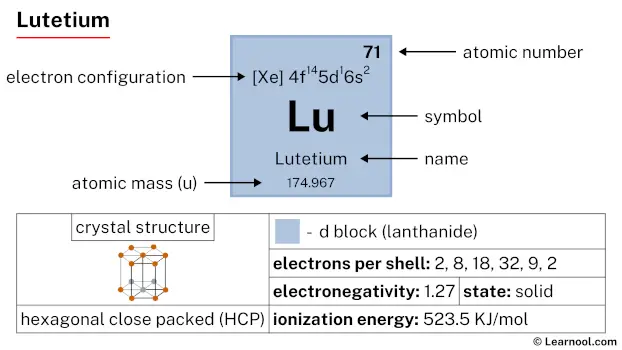
Lutetium (Lu) is a chemical element of the periodic table, located in the group 3 and the period 6, and has the atomic number 71. It is the last element in the lanthanide series. It is a silvery-white metal, whose name comes from “Lutetia”, the ancient Latin name for Paris, in the Roman era. It is counted as one of the rare earth elements.
On periodic table
| group | ⇨ | 1 | 2 | 3 | 4 | 5 | 6 | 7 | 8 | 9 | 10 | 11 | 12 | 13 | 14 | 15 | 16 | 17 | 18 |
| period | ⇩ | ||||||||||||||||||
| 1 | 1 H 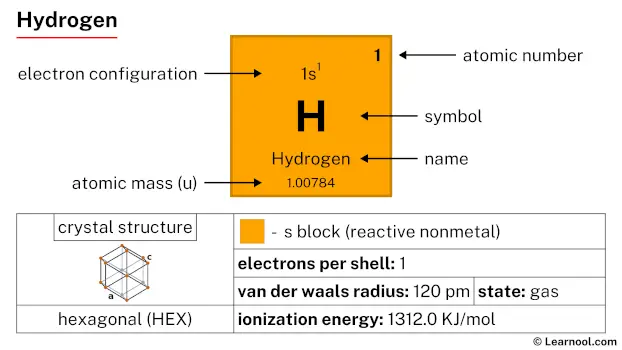 Hydrogen |
2 He  Helium |
|||||||||||||||||
| 2 | 3 Li  Lithium |
4 Be 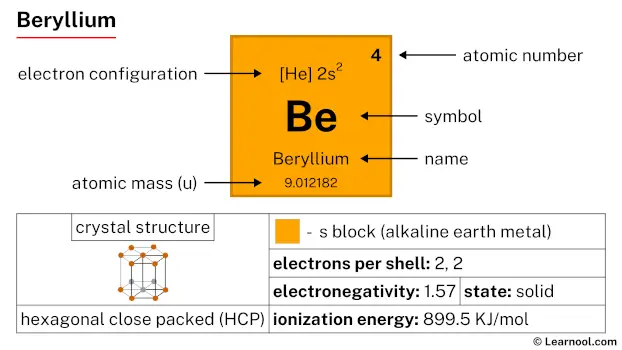 Beryllium |
5 B 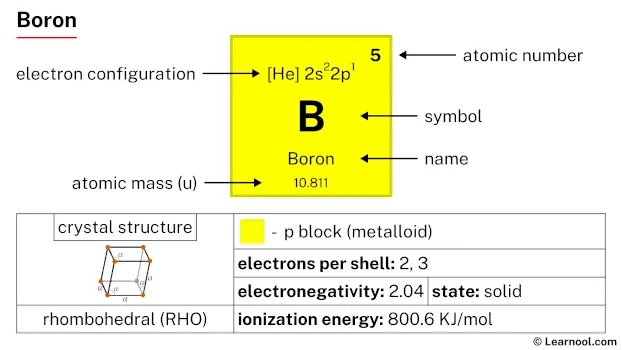 Boron |
6 C  Carbon |
7 N 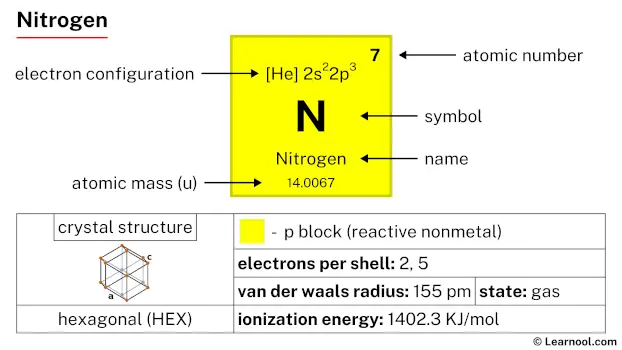 Nitrogen |
8 O 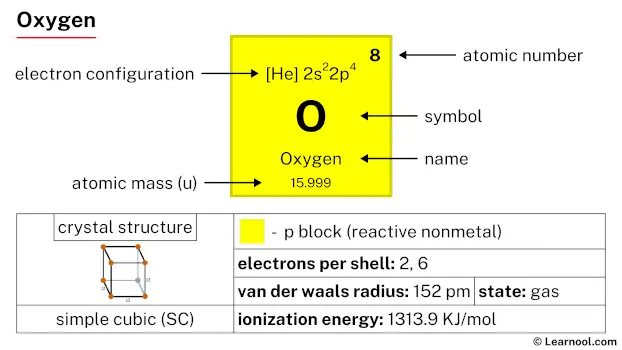 Oxygen |
9 F 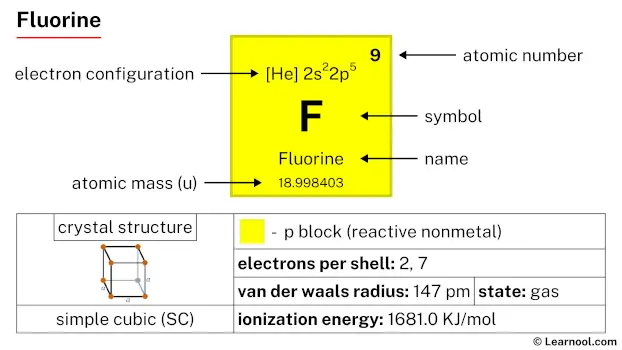 Fluorine |
10 Ne 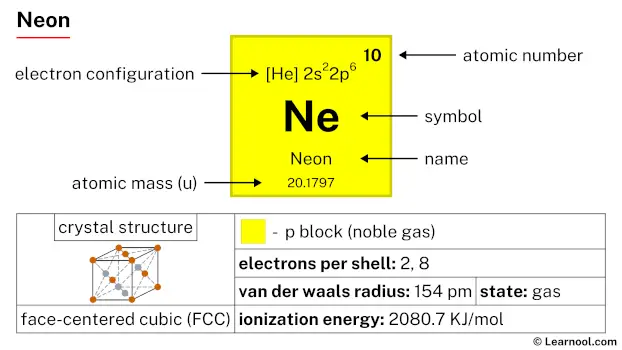 Neon |
|||||||||||
| 3 | 11 Na 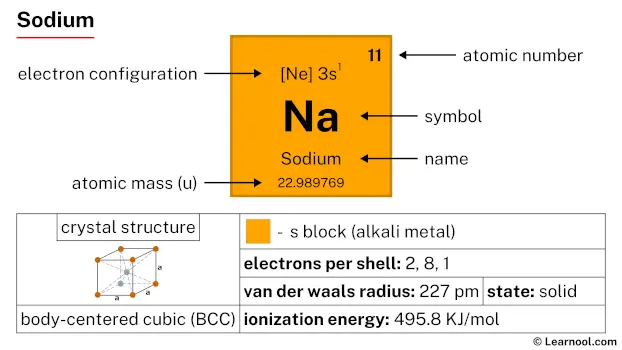 Sodium |
12 Mg 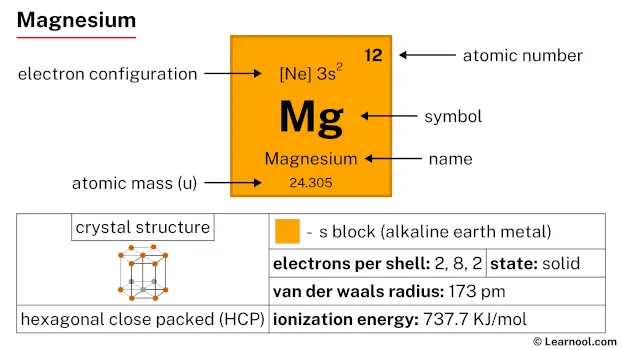 Magnesium |
13 Al  Aluminium |
14 Si Silicon |
15 P 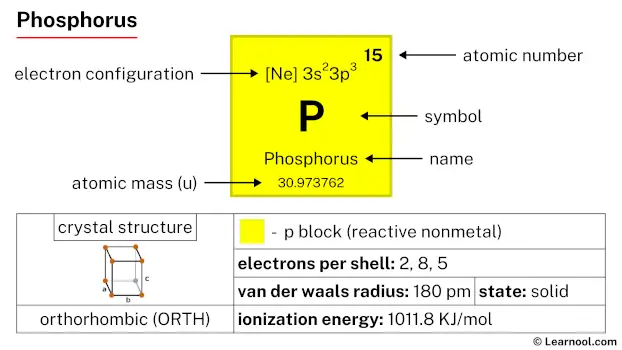 Phosphorus |
16 S 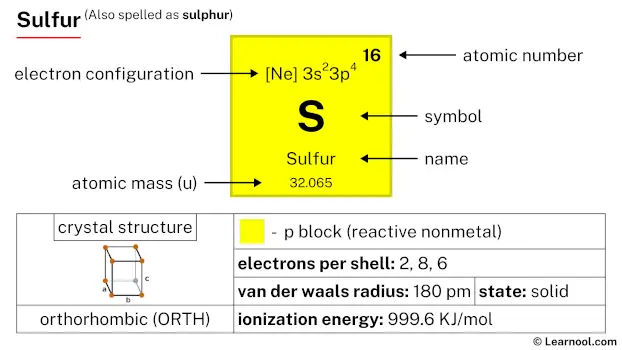 Sulfur |
17 Cl 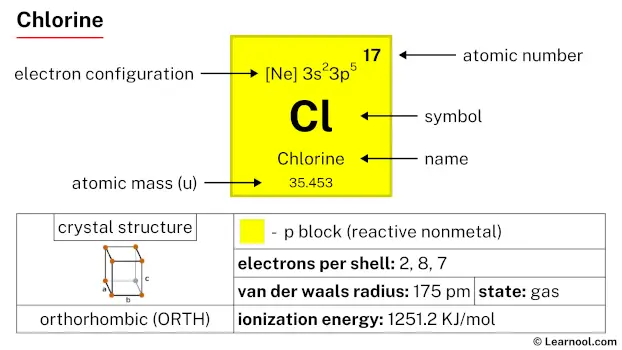 Chlorine |
18 Ar 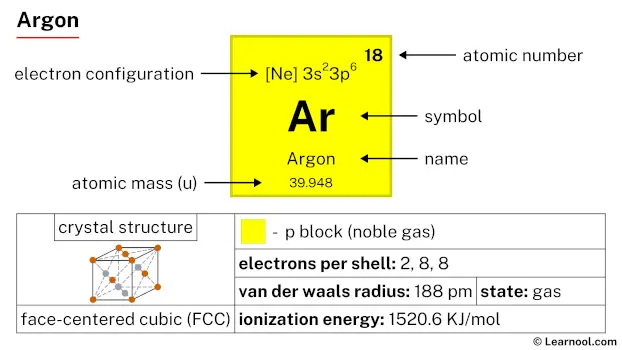 Argon |
|||||||||||
| 4 | 19 K 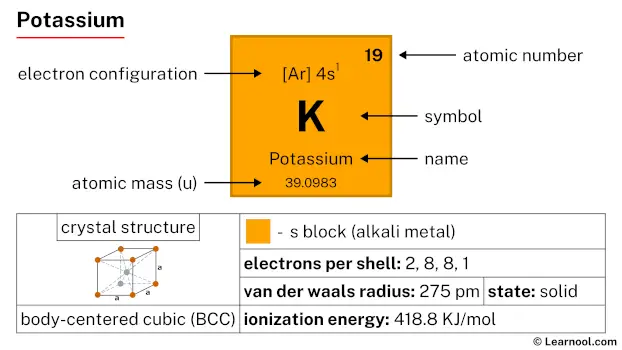 Potassium |
20 Ca 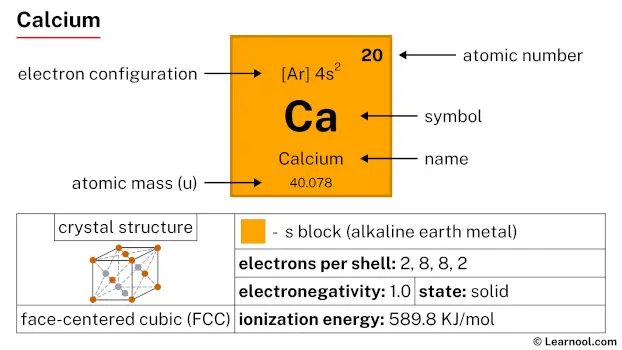 Calcium |
21 Sc 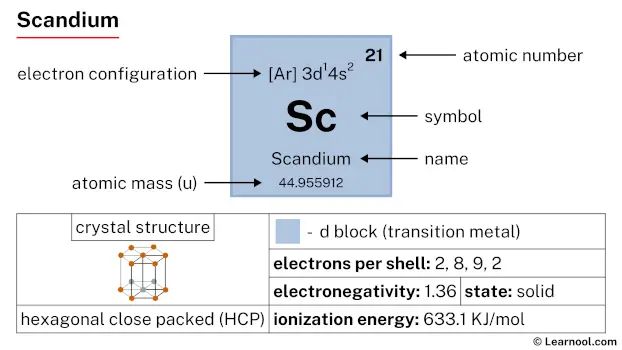 Scandium |
22 Ti 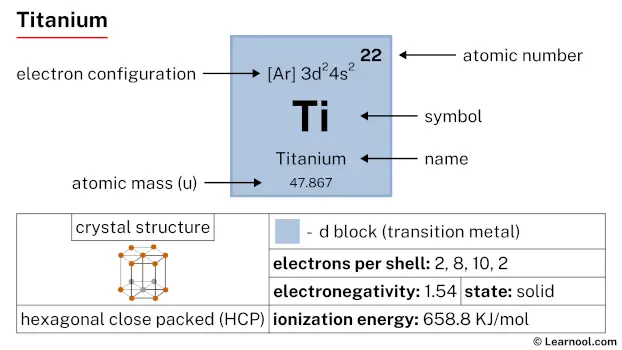 Titanium |
23 V 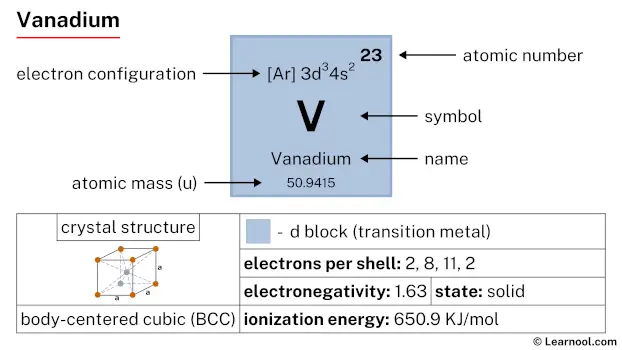 Vanadium |
24 Cr 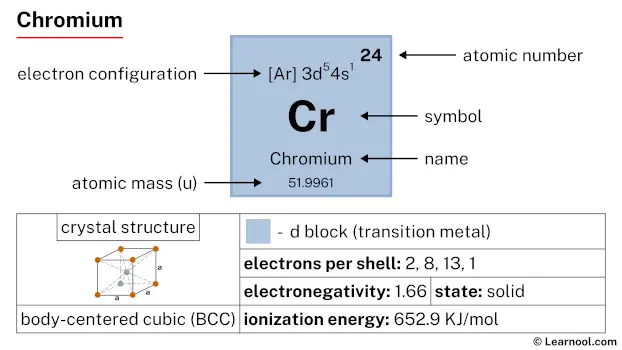 Chromium |
25 Mn 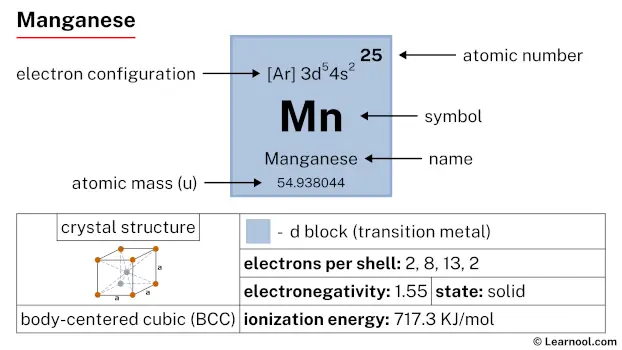 Manganese |
26 Fe 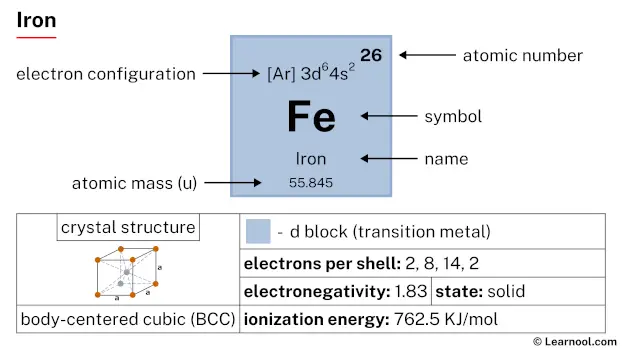 Iron |
27 Co 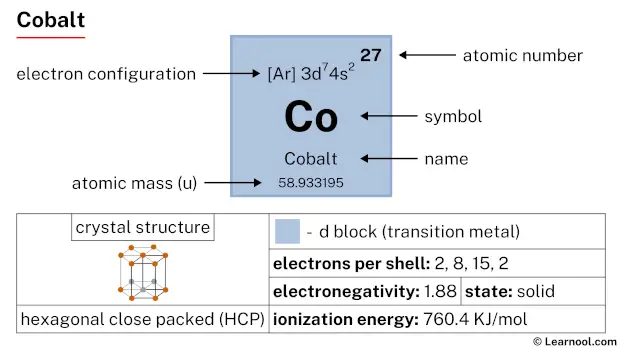 Cobalt |
28 Ni 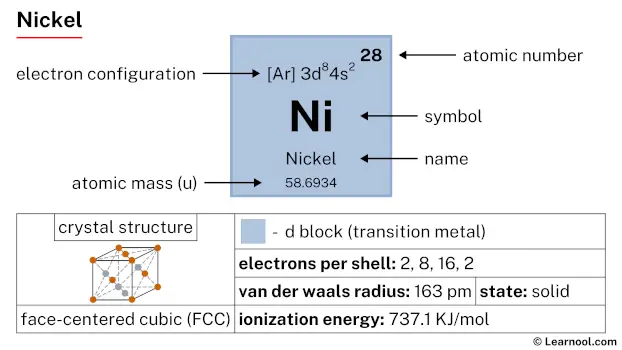 Nickel |
29 Cu 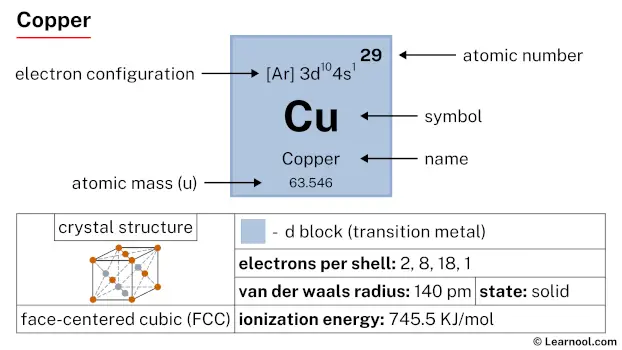 Copper |
30 Zn  Zinc |
31 Ga 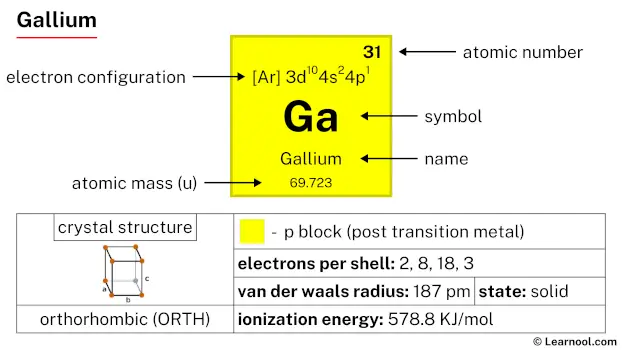 Gallium |
32 Ge 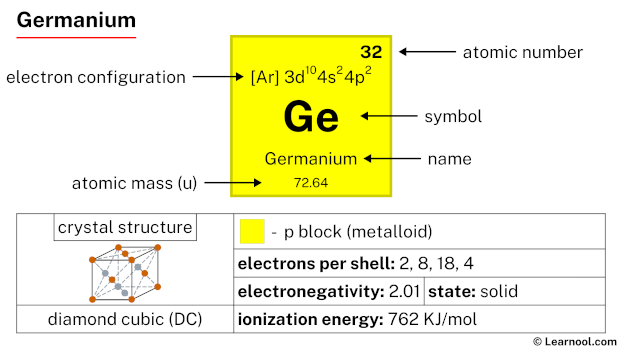 Germanium |
33 As 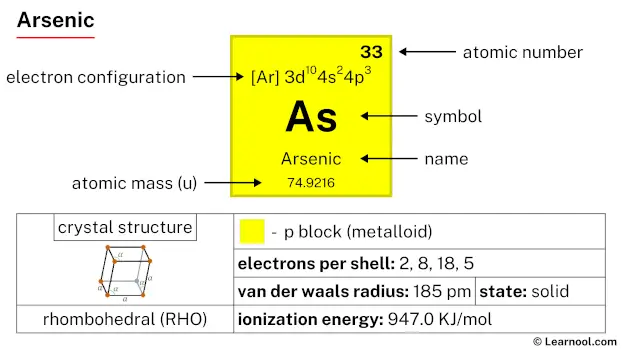 Arsenic |
34 Se 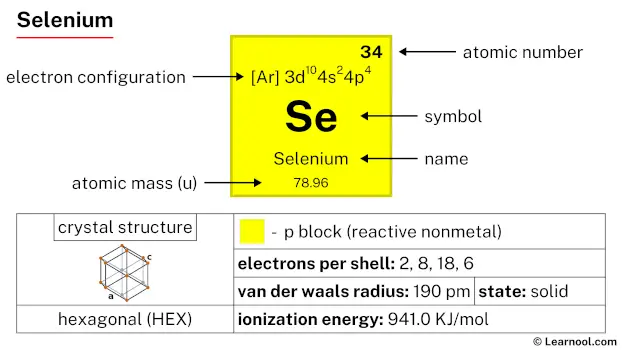 Selenium |
35 Br 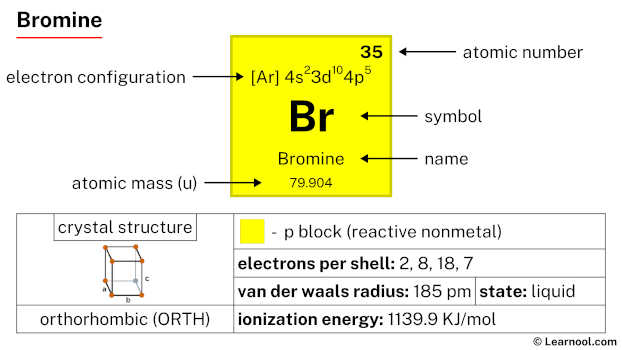 Bromine |
36 Kr  Krypton |
|
| 5 | 37 Rb 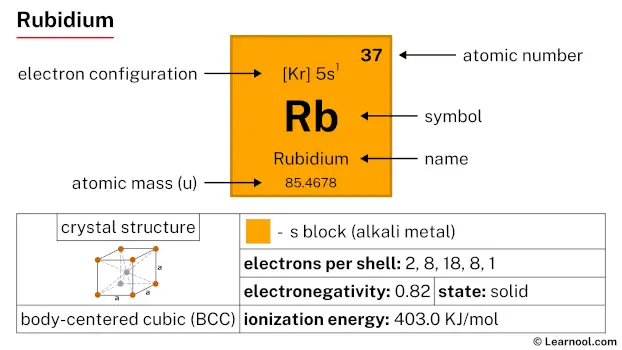 Rubidium |
38 Sr 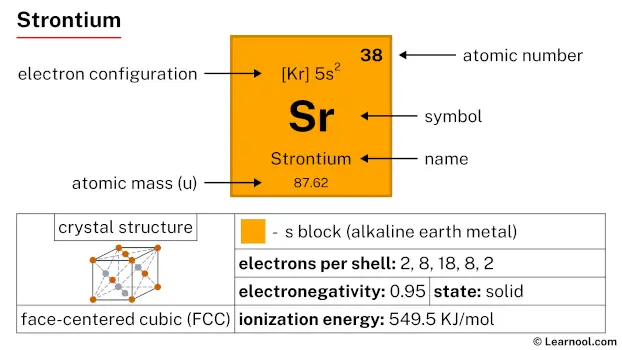 Strontium |
39 Y 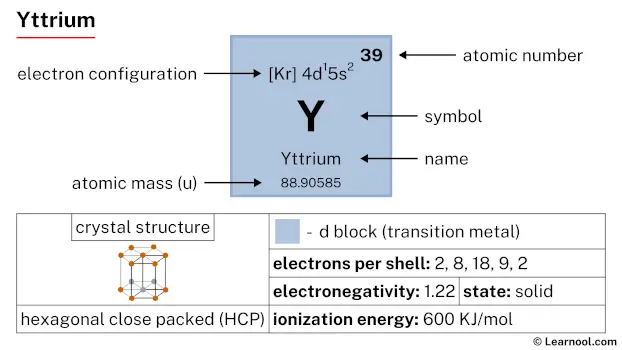 Yttrium |
40 Zr 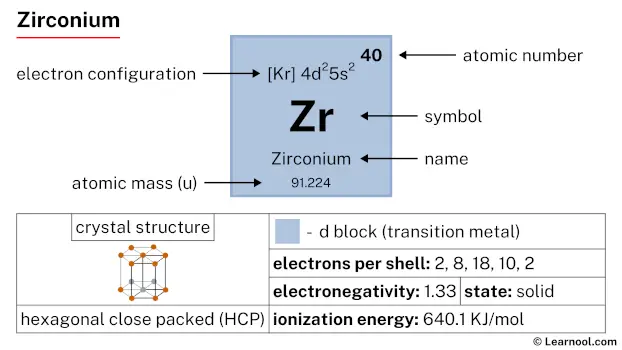 Zirconium |
41 Nb 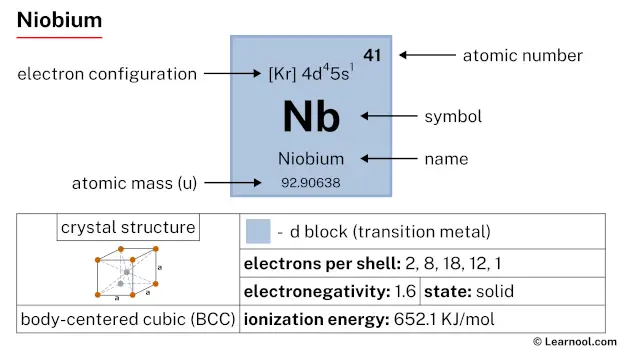 Niobium |
42 Mo 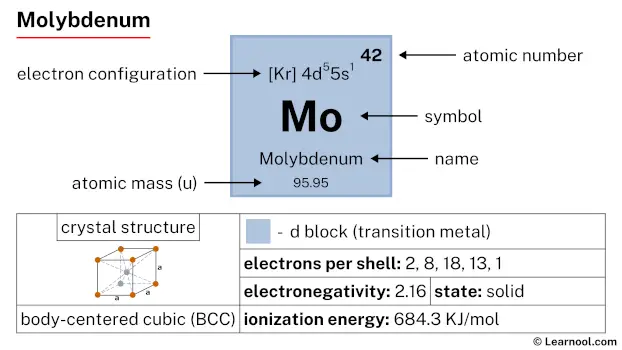 Molybdenum |
43 Tc 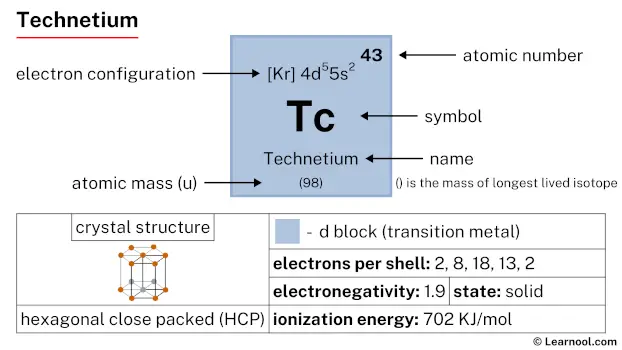 Technetium |
44 Ru 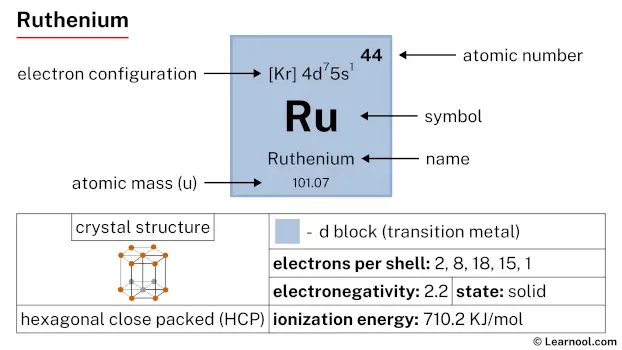 Ruthenium |
45 Rh 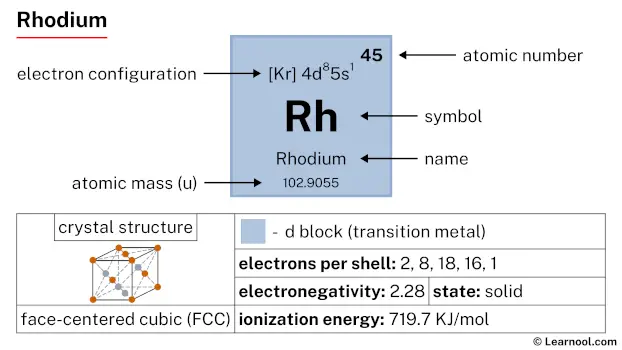 Rhodium |
46 Pd  Palladium |
47 Ag  Silver |
48 Cd 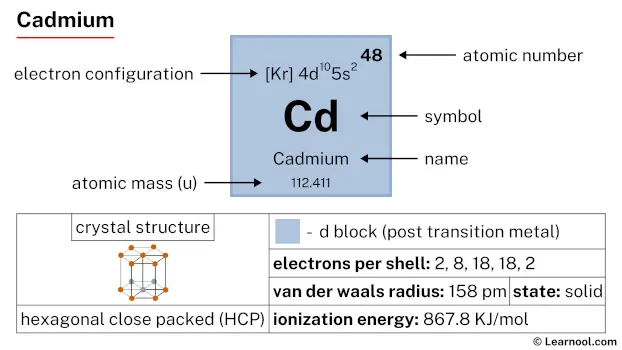 Cadmium |
49 In 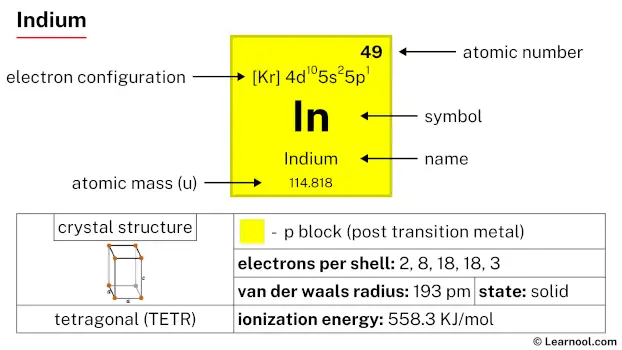 Indium |
50 Sn 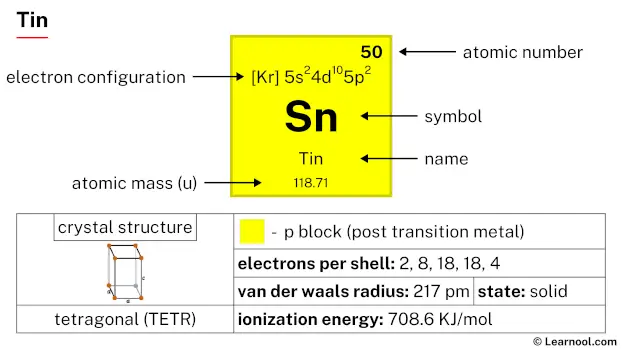 Tin |
51 Sb 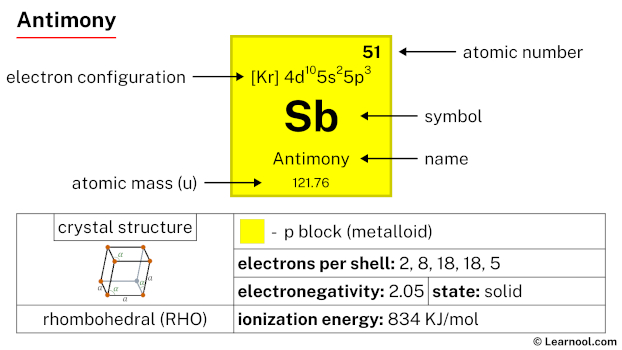 Antimony |
52 Te 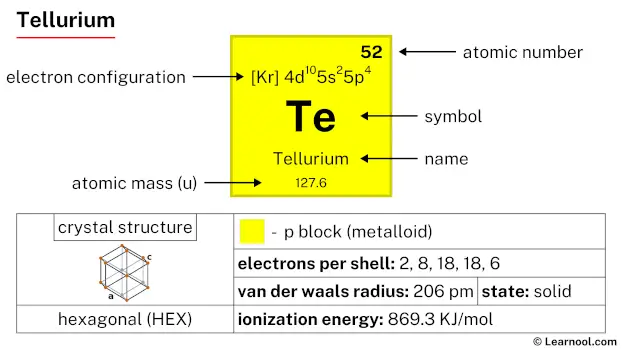 Tellurium |
53 I 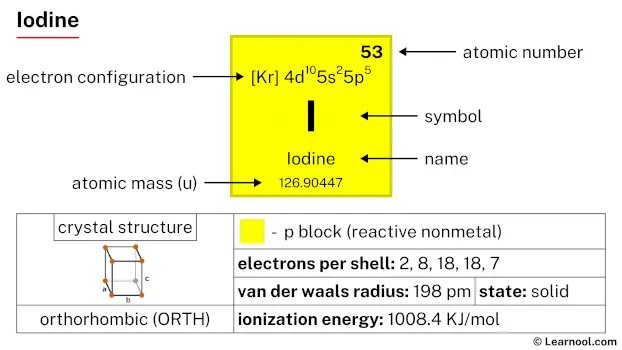 Iodine |
54 Xe 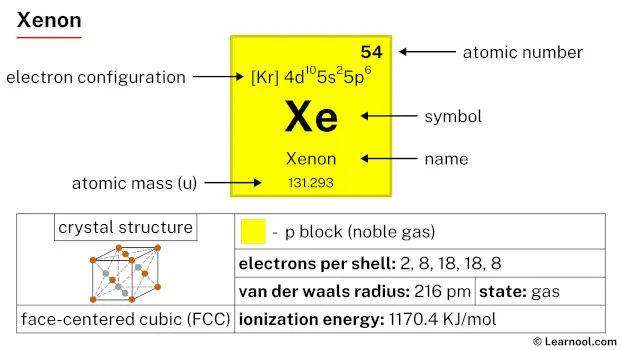 Xenon |
|
| 6 | 55 Cs 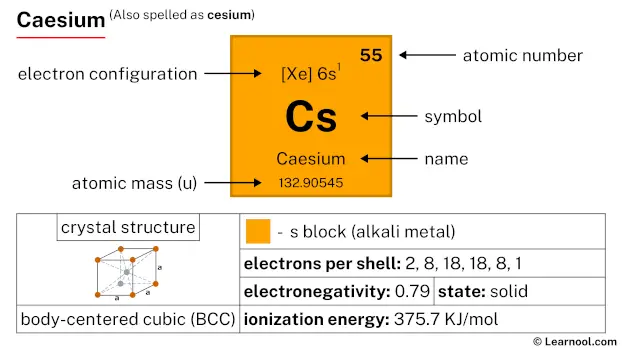 Caesium |
56 Ba 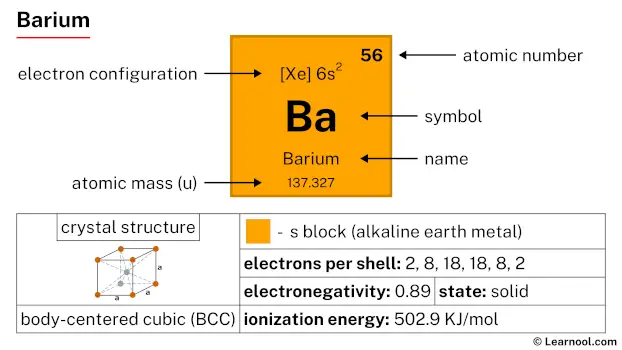 Barium |
72 Hf 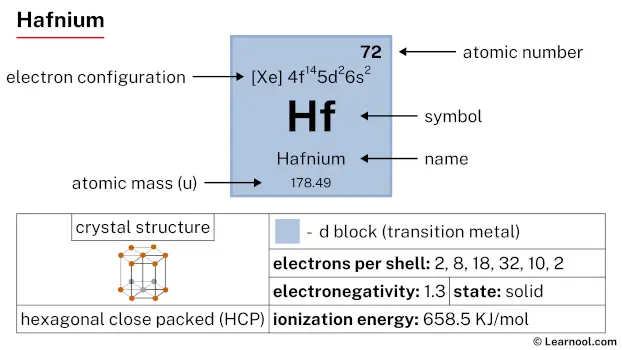 Hafnium |
73 Ta 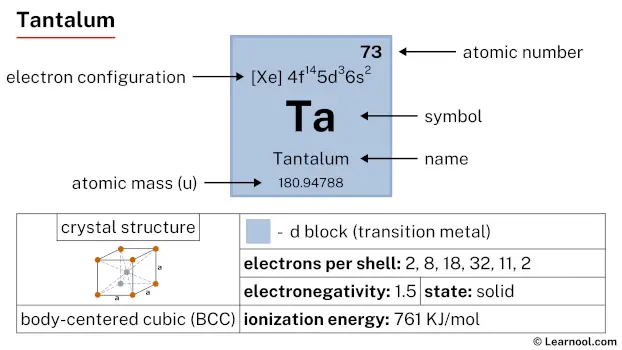 Tantalum |
74 W 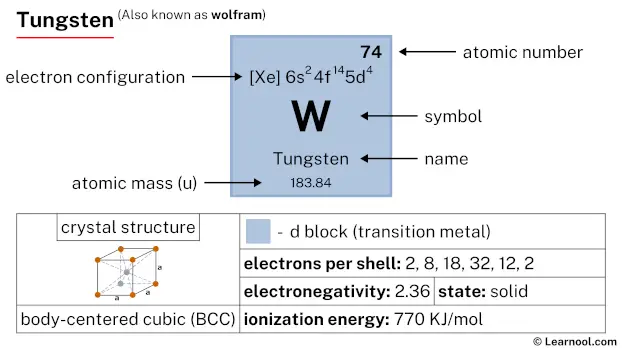 Tungsten |
75 Re 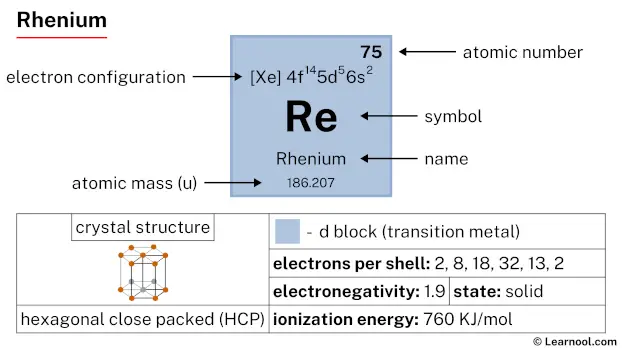 Rhenium |
76 Os 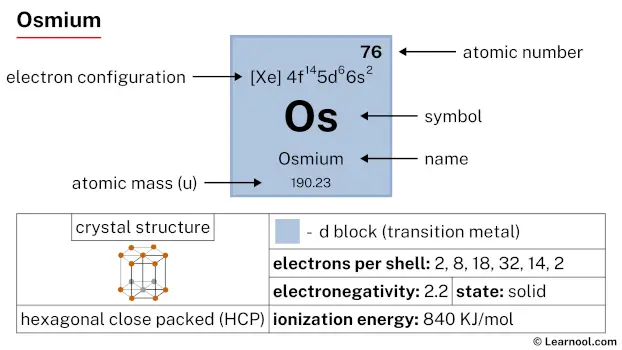 Osmium |
77 Ir 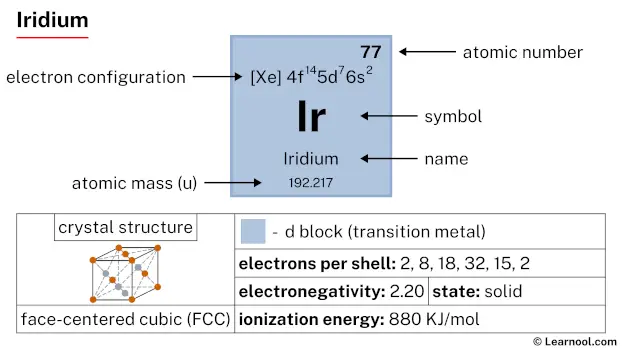 Iridium |
78 Pt  Platinum |
79 Au  Gold |
80 Hg 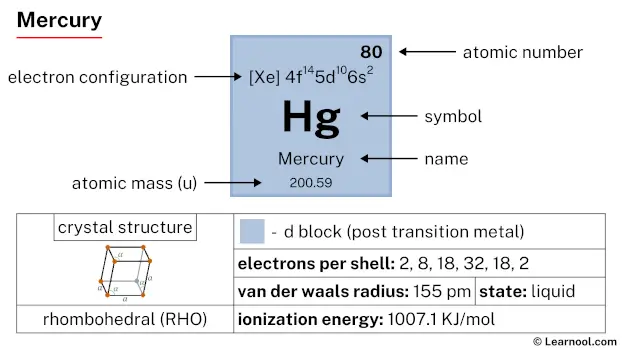 Mercury |
81 Tl 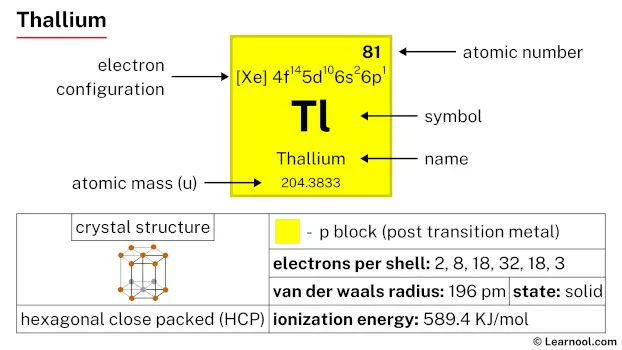 Thallium |
82 Pb  Lead |
83 Bi 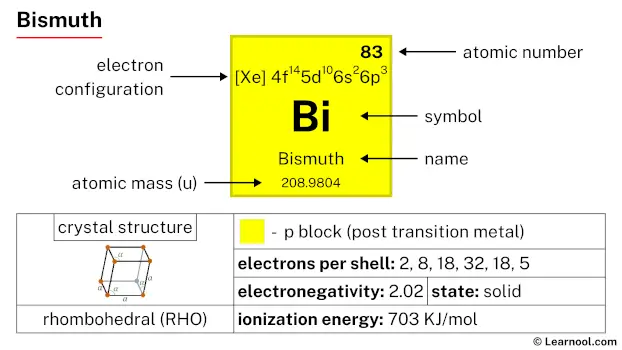 Bismuth |
84 Po 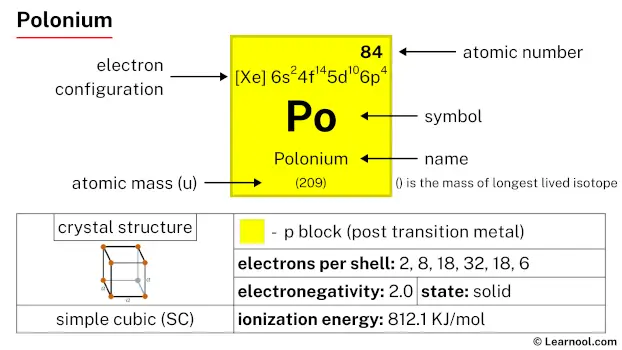 Polonium |
85 At 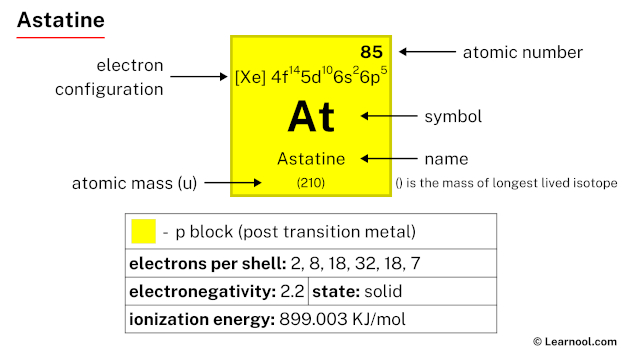 Astatine |
86 Rn 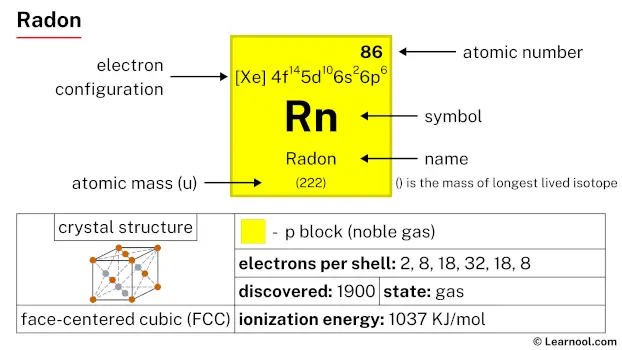 Radon |
||
| 7 | 87 Fr 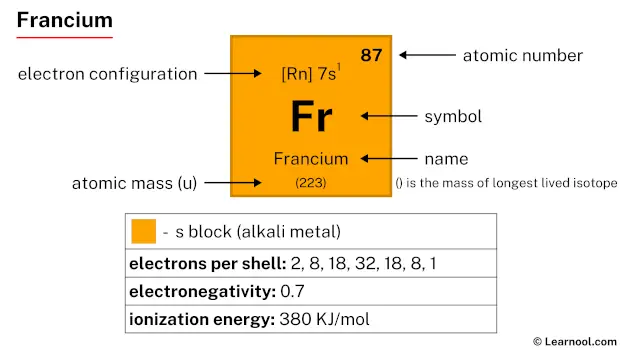 Francium |
88 Ra 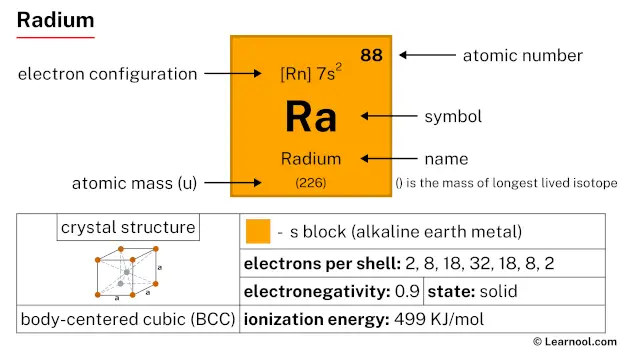 Radium |
104 Rf 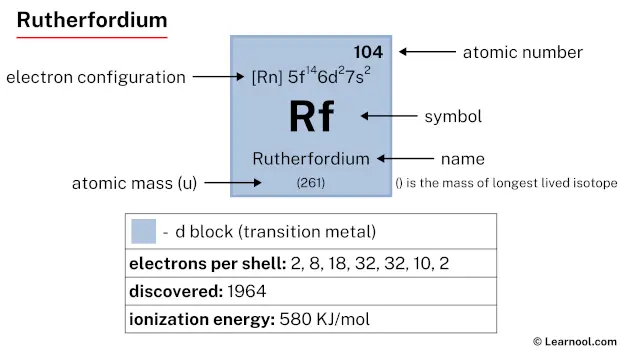 Rutherfordium |
105 Db 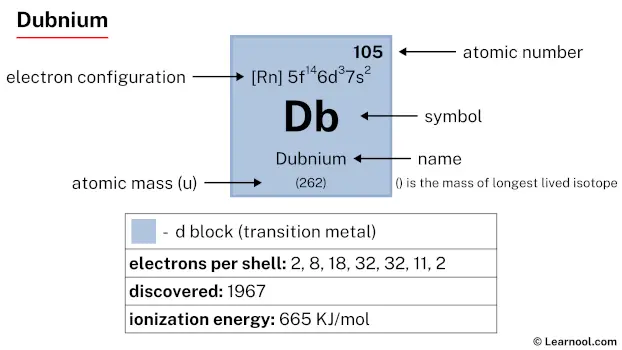 Dubnium |
106 Sg 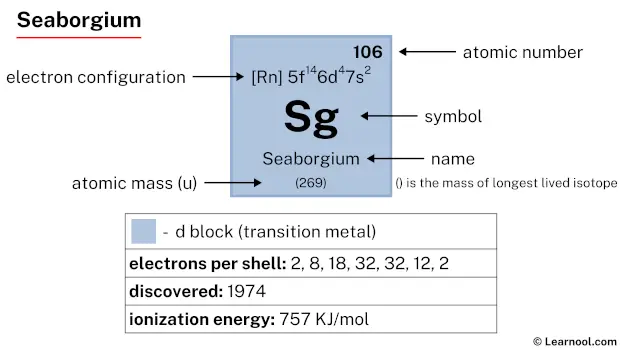 Seaborgium |
107 Bh 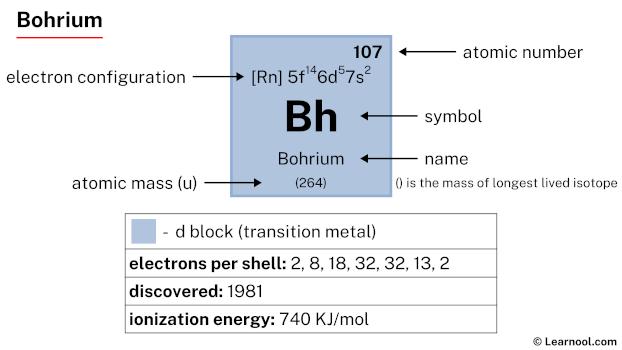 Bohrium |
108 Hs 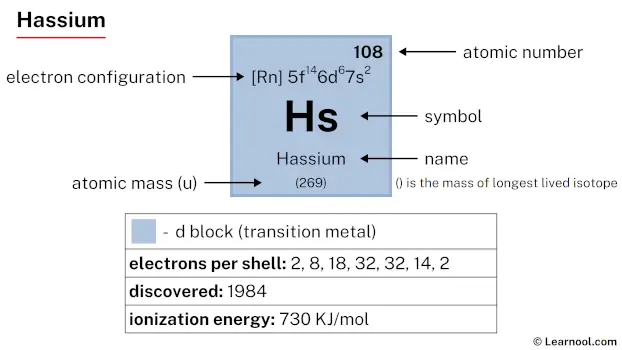 Hassium |
109 Mt 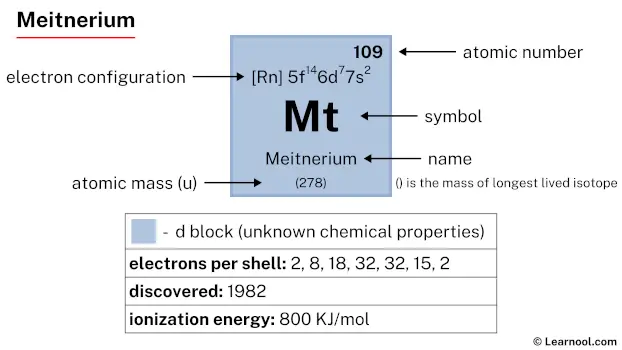 Meitnerium |
110 Ds 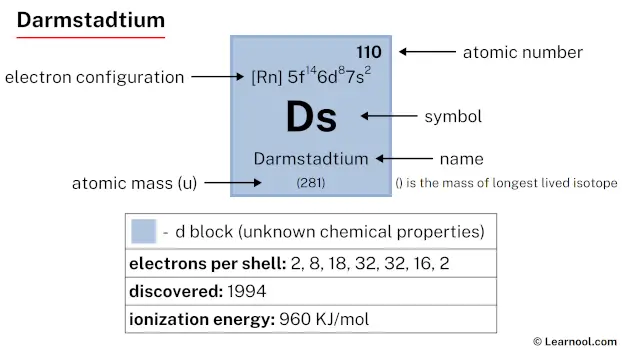 Darmstadtium |
111 Rg 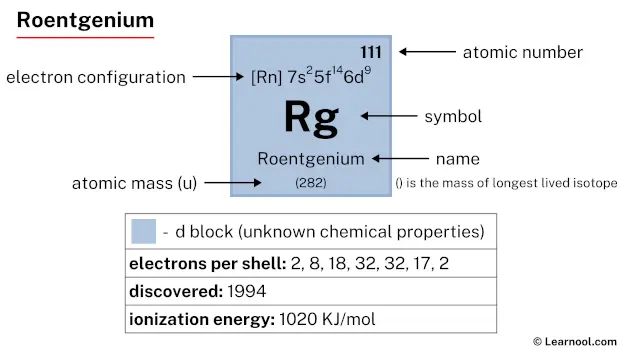 Roentgenium |
112 Cn  Copernicium |
113 Nh 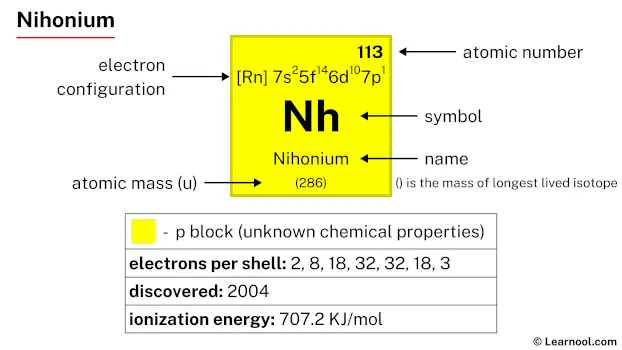 Nihonium |
114 Fl 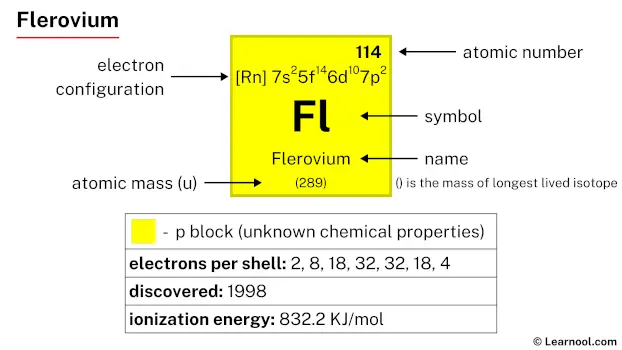 Flerovium |
115 Mc 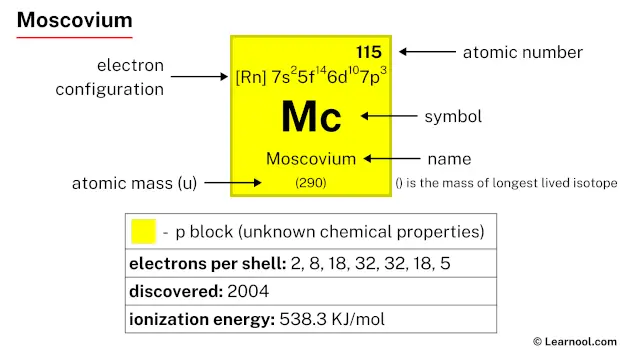 Moscovium |
116 Lv 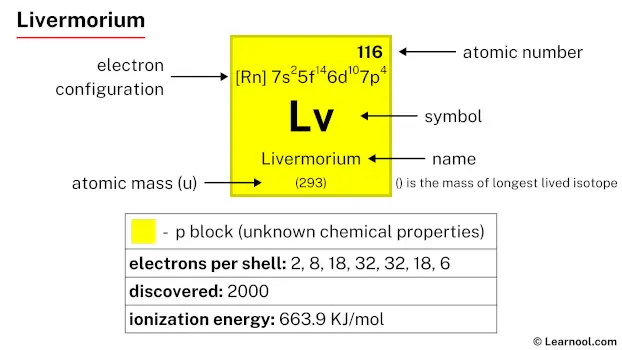 Livermorium |
117 Ts 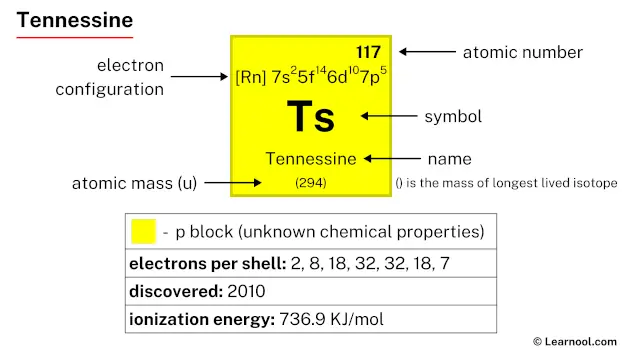 Tennessine |
118 Og 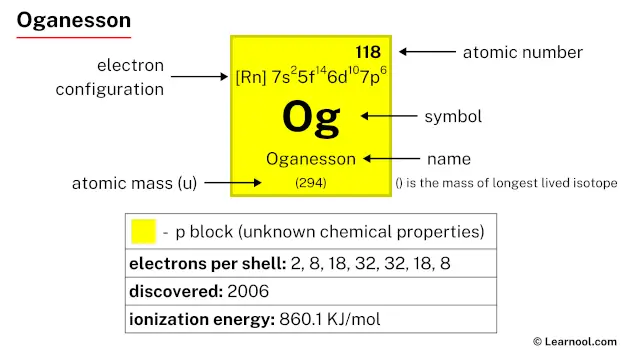 Oganesson |
||
| 57 La 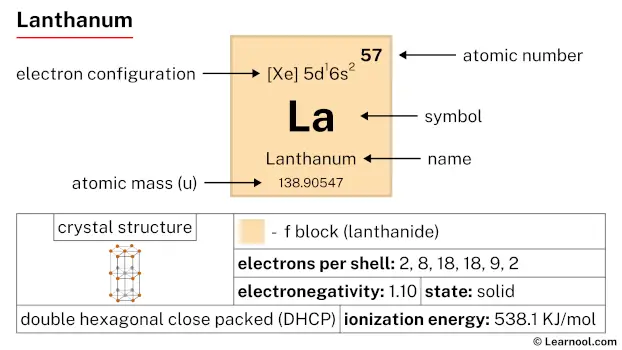 Lanthanum |
58 Ce 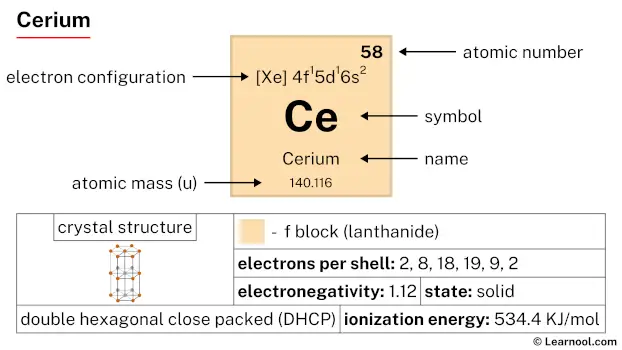 Cerium |
59 Pr 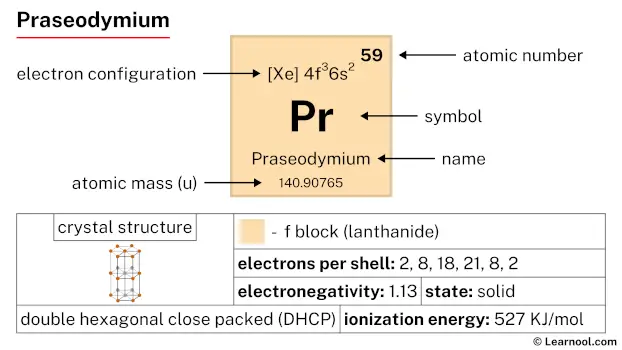 Praseodymium |
60 Nd 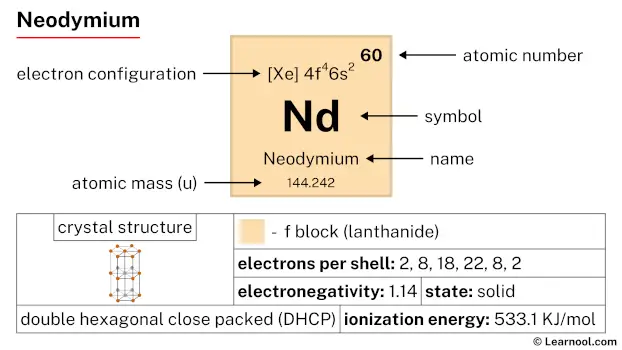 Neodymium |
61 Pm 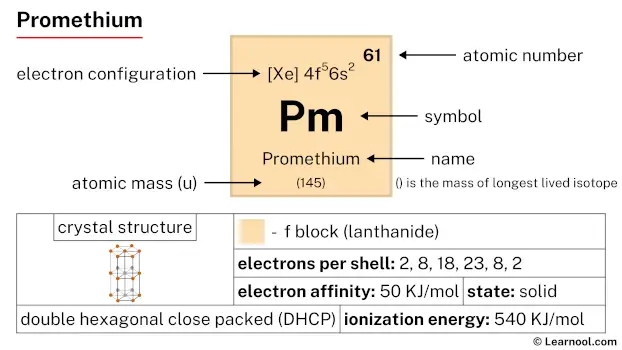 Promethium |
62 Sm 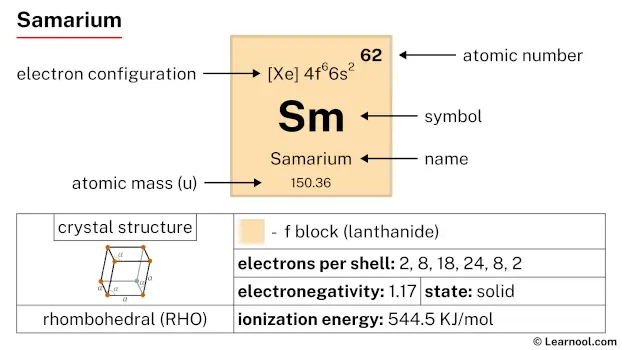 Samarium |
63 Eu 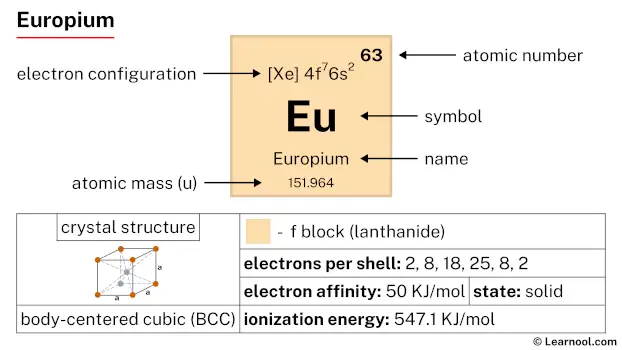 Europium |
64 Gd 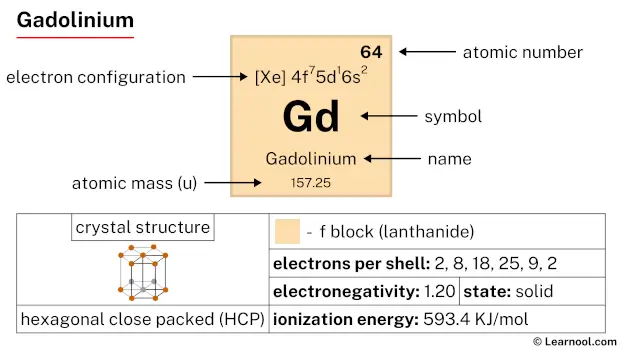 Gadolinium |
65 Tb 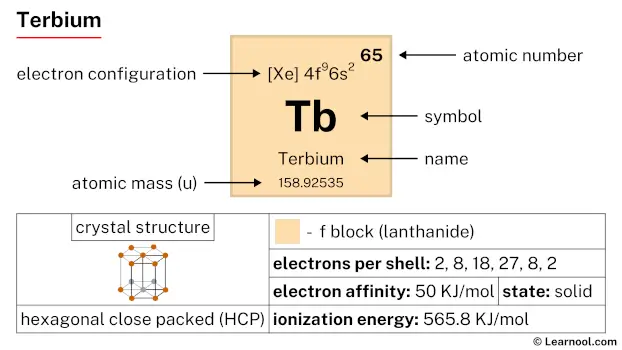 Terbium |
66 Dy 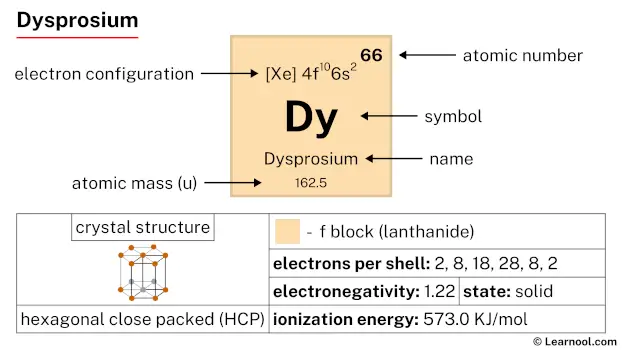 Dysprosium |
67 Ho 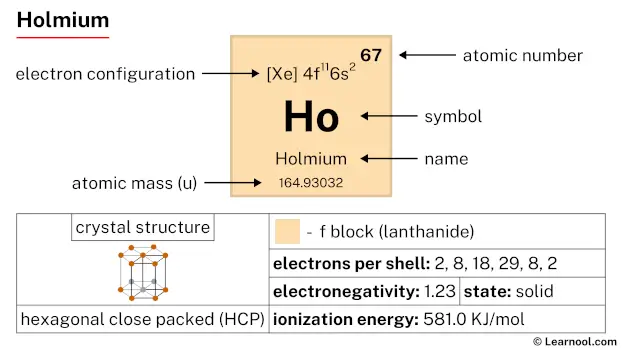 Holmium |
68 Er 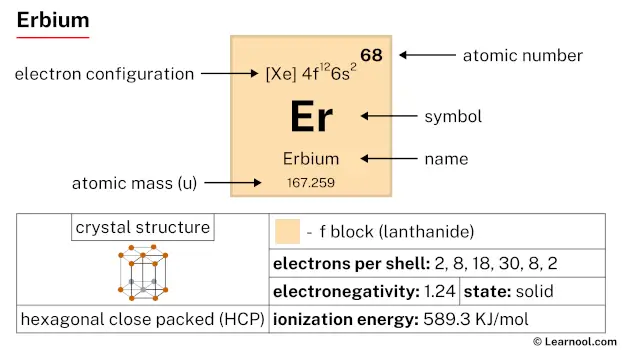 Erbium |
69 Tm 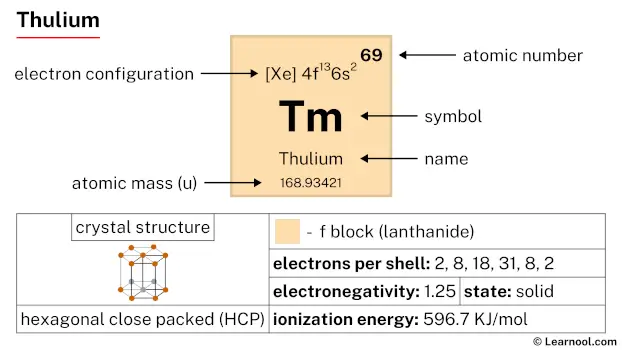 Thulium |
70 Yb 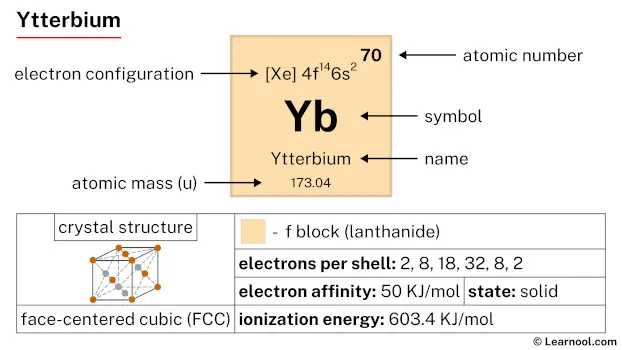 Ytterbium |
71 Lu Lutetium |
|||||
| 89 Ac 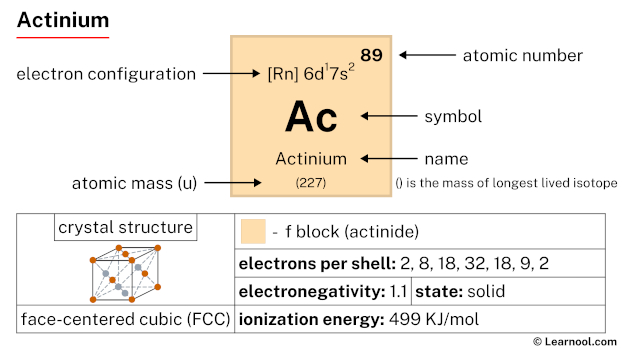 Actinium |
90 Th 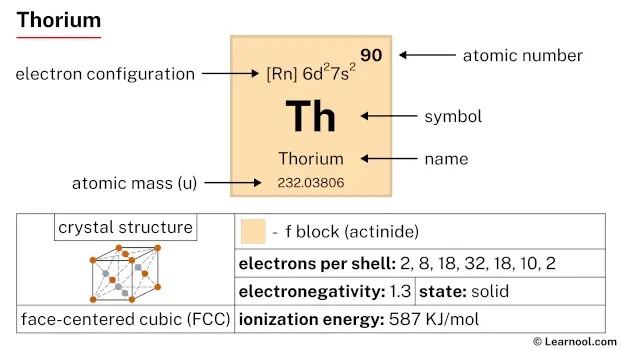 Thorium |
91 Pa 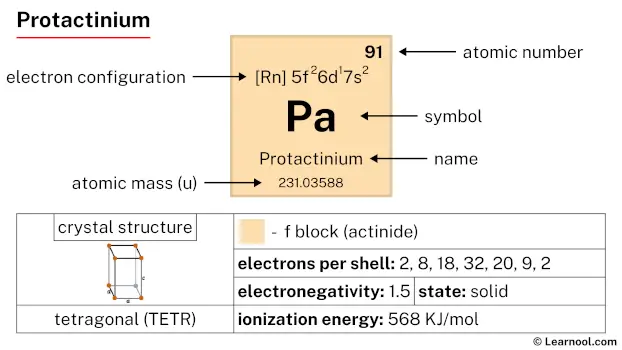 Protactinium |
92 U 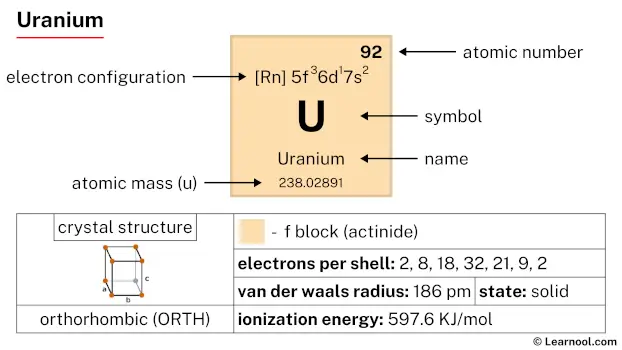 Uranium |
93 Np 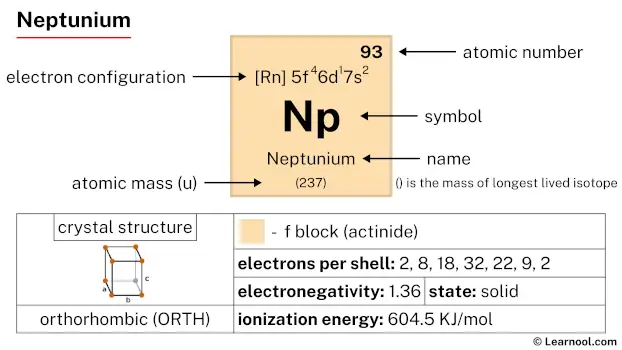 Neptunium |
94 Pu 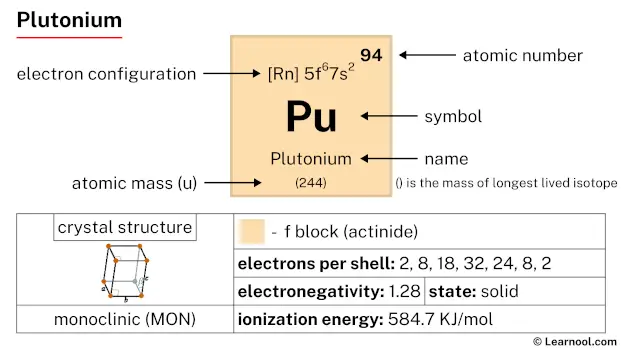 Plutonium |
95 Am  Americium |
96 Cm 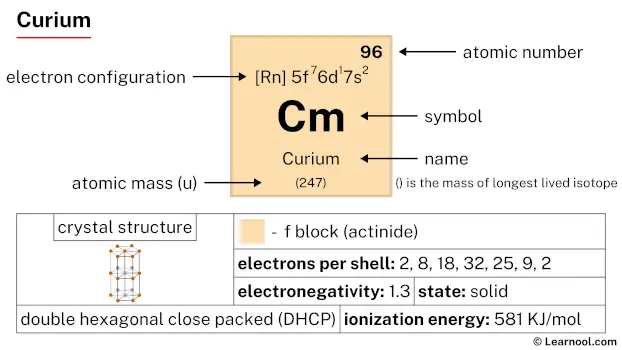 Curium |
97 Bk 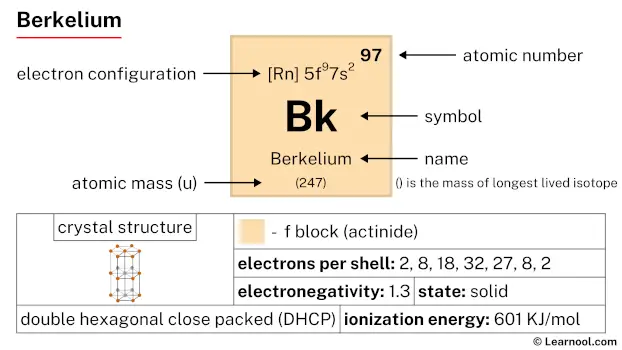 Berkelium |
98 Cf 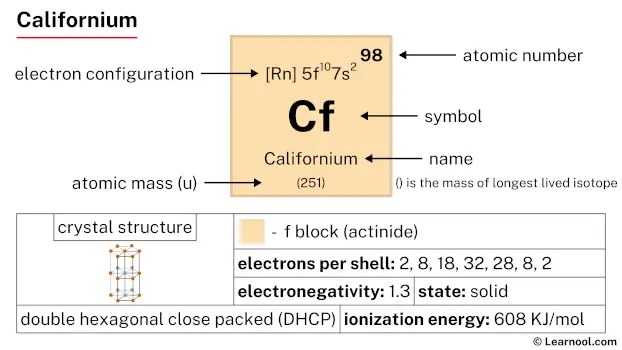 Californium |
99 Es 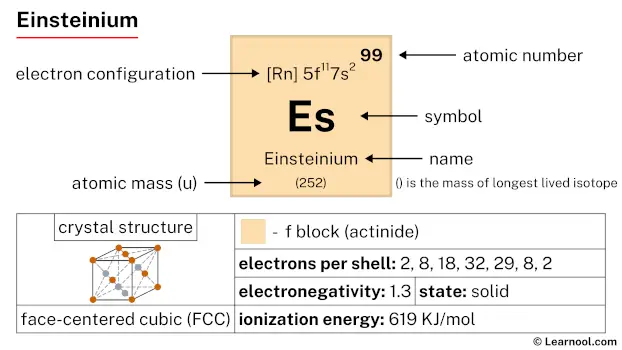 Einsteinium |
100 Fm 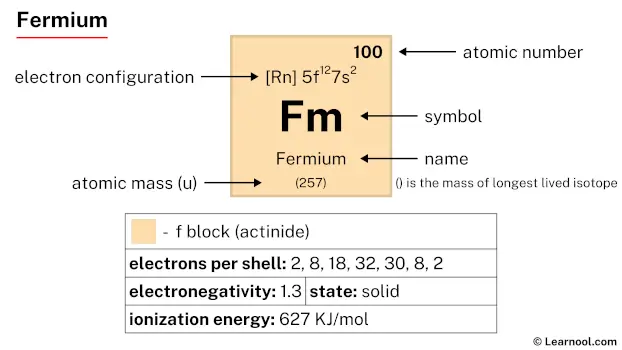 Fermium |
101 Md 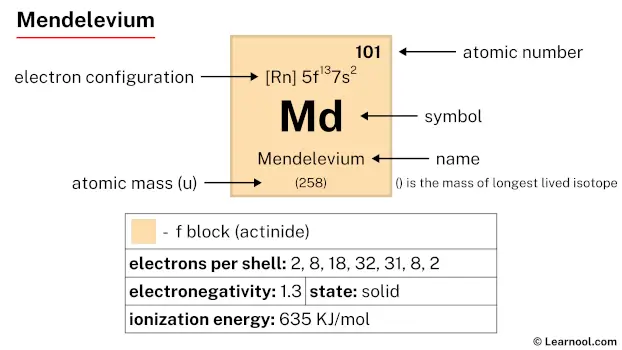 Mendelevium |
102 No 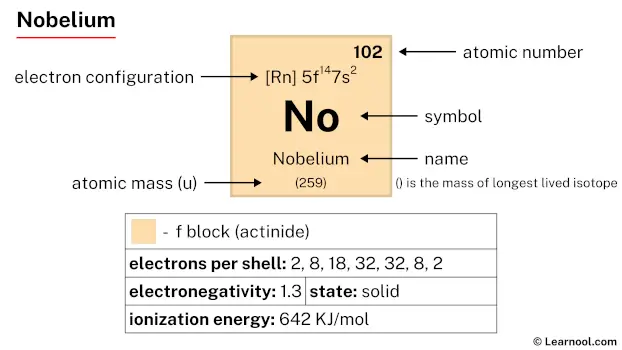 Nobelium |
103 Lr 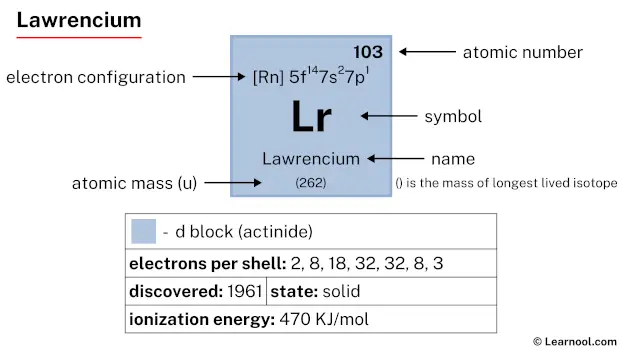 Lawrencium |
|||||
| – d block |
Lutetium is found in the lanthanide series, a group of elements located at the bottom of the periodic table. Specifically, in period 6, next to ytterbium (Yb).
Element information
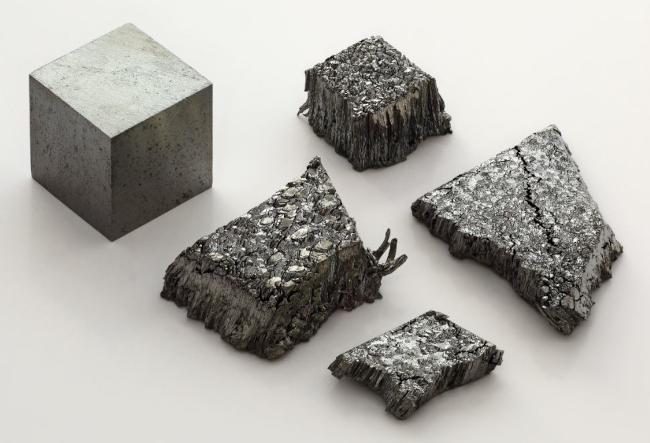 |
|
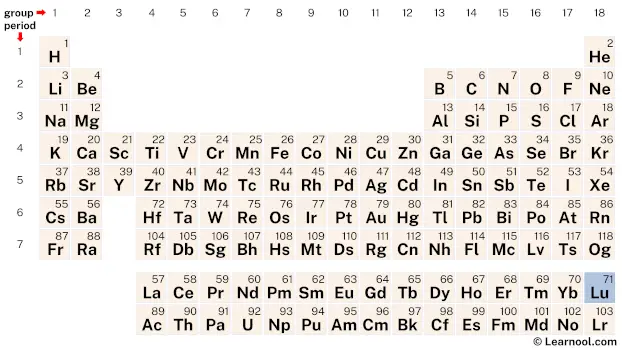 |
|
| Origin of name | name comes from Lutetia, the ancient Latin name for Paris |
| Symbol | Lu |
| Atomic number (Z) | 71 |
| Atomic mass | 174.967 u |
| Block | d-block |
| Group | 3 |
| Period | 6 |
| Classification | Lanthanide |
| Atomic radius | 174 pm |
| Covalent radius | 187±8 pm |
| Melting point | 1652 ℃, 3006 ℉, 1925 K |
| Boiling point | 3402 ℃, 6156 ℉, 3675 K |
| Electron configuration | [Xe] 4f14 5d1 6s2 |
| Electrons per shell | 2, 8, 18, 32, 9, 2 |
| Crystal structure | Hexagonal close-packed (hcp) |
| Phase at r.t | Solid |
| Density near r.t | 9.841 g/cm3 |
| Main isotopes | Lutetium-175 |
| Natural occurrence | Primordial |
| Oxidation state | +3 |
| Electronegativity (Pauling scale) | 1.27 |
| Protons Neutrons Electrons |
71 104 71 |
| Learn how to find: Lutetium protons neutrons electrons | |
| CAS number | 7439-94-3 |
| Discovered by | Carl Auer von Welsbach and Georges Urbain in 1907 |
History
Lutetium was first discovered in 1907 by the French scientist Georges Urbain and his collaborators Carl Auer von Welsbach and Charles James. They identified the element in ytterbia, which was previously believed to contain only one element, ytterbium. The discovery of lutetium was controversial at the time, with some scientists arguing that the element was actually a mixture of ytterbium and a new, unidentified element.
In 1909, the Austrian scientist Baron von Welsbach announced that he had successfully isolated pure lutetium, settling the debate once and for all. The name “lutetium” comes from the Latin name for Paris, Lutetia, as Urbain’s discovery of the element was announced during the International Exhibition in Paris in 1900.
In the years that followed, scientists worked to better understand the properties of lutetium and its place in the periodic table. It wasn’t until 1949 that the American chemist Frank Spedding and his team at Iowa State University succeeded in isolating large quantities of the element using ion exchange chromatography. Since then, lutetium has been produced in larger quantities and its properties have been studied in more detail, leading to a better understanding of its applications in various fields.
Occurrence and production
Lutetium is one of the rarest and least abundant elements on earth. It is the last and the smallest member of the lanthanide series, which is a group of elements with similar properties. Lutetium has an average concentration of 0.5 parts per million (ppm) in the earth’s crust, which makes it the 60th most abundant element. It is mainly found in the minerals monazite and xenotime, which are rare earth minerals. Lutetium is also found in the minerals yttrium, gadolinite, euxenite, and some other minerals.
The production of lutetium is a complex process that involves several steps. It is usually obtained as a byproduct of the production of other rare earth elements such as yttrium and cerium. The most common method for the production of lutetium is ion exchange chromatography, which is a separation technique based on the ability of different ions to interact differently with a solid phase.
The ion exchange chromatography involves the use of a resin column, which is filled with an ion exchange resin that has a high affinity for lutetium ions. The rare earth elements are dissolved in a solution, which is then passed through the resin column. The lutetium ions bind to the resin, while the other rare earth ions pass through the column. The lutetium ions are then eluted from the resin column with an acid solution.
Another method for the production of lutetium is the reduction of its oxide with calcium metal in a high-temperature vacuum furnace. The resulting product is then further purified using various techniques such as zone melting, distillation, and electrolysis. However, this method is less commonly used due to the high cost and complexity involved in the process.
Properties
Lutetium is a rare earth metal and a member of the lanthanide series on the periodic table.
Lutetium is a silver-white metal that is relatively stable in air, but reacts slowly with water and dissolves readily in diluted acids.
Lutetium has the highest density and melting point of all the lanthanides.
Lutetium is a relatively hard metal and has a high Young’s modulus, making it useful in high-strength alloys.
Lutetium is paramagnetic at room temperature, meaning that it has magnetic properties but does not retain a permanent magnetization.
Lutetium is also notable for its nuclear properties, as it has several stable isotopes and can be used in nuclear medicine imaging.
Applications
Lutetium-177 is used as a radiopharmaceutical in cancer therapy. It emits beta particles that can penetrate cancerous cells and destroy them from the inside.
Lutetium oxide is used as a catalyst in various chemical reactions. It is particularly useful in the production of high octane gasoline, as well as in the polymerization of olefins.
Lutetium-176 is used as a target material for the production of radioactive isotopes, such as molybdenum-99, which is used in medical imaging.
Lutetium-based phosphors are used in the production of energy-efficient light bulbs, such as LEDs.
Lutetium-doped crystals are used in the production of solid-state lasers, which have a wide range of industrial and scientific applications.
Lutetium-based alloys are being investigated for use in magnetic refrigeration, which could provide a more energy-efficient and environmentally friendly alternative to traditional refrigeration methods.
Interesting facts
Lutetium is the last naturally occurring element of the lanthanide series, which makes it the rarest and most expensive of all the rare earth metals.
It was discovered independently by three scientists – Georges Urbain, Carl Auer von Welsbach, and Charles James in the early 20th century.
Its name is derived from “Lutetia”, the Latin name for Paris, where Urbain conducted his research.
Lutetium is a silvery-white metal that can be cut with a knife and is relatively stable in air.
It has the highest density and melting point of all the lanthanide elements.
Lutetium is not used in many commercial applications due to its rarity and expense, but it is used in specialized fields such as nuclear medicine, petroleum refining, and certain types of catalysts.
Its radioactive isotopes have been used in cancer therapy and nuclear medicine imaging.
Lutetium-176 is used in the field of geochronology to determine the age of the Earth and meteorites.
Lutetium is not considered to be toxic, but like all rare earth metals, it should be handled with care.
Related
More elements
External links
- https://en.wikipedia.org/wiki/Lutetium
- https://www.rsc.org/periodic-table/element/71/lutetium
- https://www.britannica.com/science/lutetium
- https://www.chemicool.com/elements/lutetium.html
- https://pubchem.ncbi.nlm.nih.gov/element/Lutetium
Deep
Learnool.com was founded by Deep Rana, who is a mechanical engineer by profession and a blogger by passion. He has a good conceptual knowledge on different educational topics and he provides the same on this website. He loves to learn something new everyday and believes that the best utilization of free time is developing a new skill.
